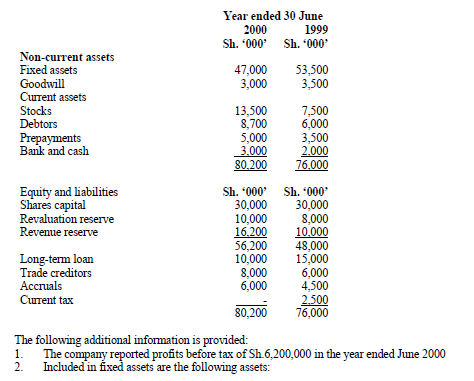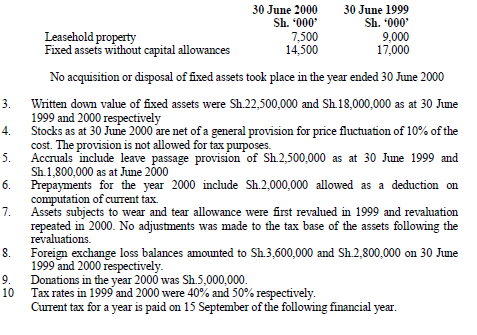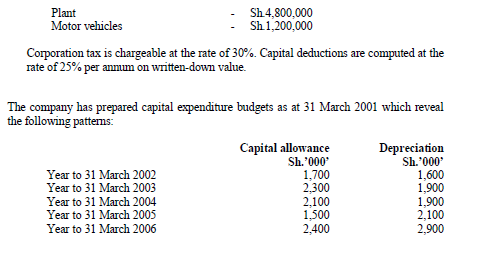
Under the partial provision method, deferred tax assets and liabilities were recognised where there was reasonable evidence that timing differences would reverse in the near future. The original IAS 12 permitted an enterprise not to recognize deferred tax assets and liabilities where there was reasonable evidence that timing differences would not reverse for considerable period ahead. IAS 12 revised requires an enterprise to recognize a deferred tax liability or (subject to certain conditions) assets for all temporary differences with certain exceptions. IAS 12 is consistent with the principles which underlie the recognition of assets and liabilities in the balance sheet as laid down in the framework for the preparation and presentation of financial= statements. As per the framework an asset is a resource controlled by the enterprise as a result of past events and from which future economic benefits are expected to flow to the enterprise. A liability is a present obligation of the enterprise arising from past events the statement of which is expected to result in an outflow of resources embodying economic benefits.
The framework further provides the recognition criteria for assets & liabilities;
- If it is probable that any future economic benefits associated with the asset or liability
will fall to or from the enterprise.
- The asset or liability has a value that can be measured with reliability
The partial provision approach regards only the limited future of the liability rather than the complete life-span of the liability. This is an adhoc position rather than one based on the principles laid down in the framework for recognition of liabilities. The requirement of IAS 12 on the other hand, is consistent with the principles which underlie the recognition of assets and liabilities in the balance sheet as laid down in the framework for the preparation and presentation of financial statements
Wilfykil answered the question on February 8, 2019 at 08:11
-
Calculate The current tax account, deferred tax account and revaluation account for the years 1999 and 2000
(Solved)
Jallam Co. Ltd. had been preparing its financial statements using actual taxes payable method for computing tax expense. In the year ended 30 June 2000, the company changed to deferred tax method and the new policy was to be applied retroactively to the accounts of the years ended 30 June 1999 and 2000.
The following are the balance sheets of the company for the two years ended 30 June 199 and 2000 before incorporating tax expense for the year 2000.


Calculate The current tax account, deferred tax account and revaluation account for the years 1999 and 2000
Date posted:
February 8, 2019
.
Answers (1)
-
Using the method recommended by the revised IAS 12, calculate deferred tax expense or income for the years 1999 and 2000
(Solved)
Jallam Co. Ltd. had been preparing its financial statements using actual taxes payable method for computing tax expense. In the year ended 30 June 2000, the company changed to deferred tax method and the new policy was to be applied retroactively to the accounts of the years ended 30 June 1999 and 2000.
The following are the balance sheets of the company for the two years ended 30 June 199 and 2000 before incorporating tax expense for the year 2000.


Using the method recommended by the revised IAS 12, calculate deferred tax expense or income for the years 1999 and 2000
Date posted:
February 8, 2019
.
Answers (1)
-
Jallam Co. Ltd. had been preparing its financial statements using actual taxes payable method for computing tax expense. In the year ended 30 June 2000,...
(Solved)
Jallam Co. Ltd. had been preparing its financial statements using actual taxes payable method for computing tax expense. In the year ended 30 June 2000, the company changed to deferred tax method and the new policy was to be applied retroactively to the accounts of the years ended 30 June 1999 and 2000.
The following are the balance sheets of the company for the two years ended 30 June 199 and 2000 before incorporating tax expense for the year 2000.


Calculate Current tax for the year ended 30 June 2000
Date posted:
February 8, 2019
.
Answers (1)
-
Compute the deferred tax charge for the year ended 31 March 2001 on: 1. Full-provision basis 2. Partial-provision basis
(Solved)
Baobab Ltd. was incorporated on 1 April 2000. In the year ended 31 March 2001, the company made a profit before taxation of Sh.10,000,000 (depreciation charged being Sh.1,000,000). The company had made the following capital additions:


Compute the deferred tax charge for the year ended 31 March 2001 on:
1. Full-provision basis
2. Partial-provision basis
(Show the profit and loss account and balance sheet extracts with respect to the provisions under each method).
Date posted:
February 8, 2019
.
Answers (1)
-
Compute the corporation payable for the year ended 31 March 2001
(Solved)
Baobab Ltd. was incorporated on 1 April 2000. In the year ended 31 March 2001, the company made a profit before taxation of Sh.10,000,000 (depreciation charged being Sh.1,000,000). The company had made the following capital additions:


Compute the corporation payable for the year ended 31 March 2001
Date posted:
February 8, 2019
.
Answers (1)
-
The original IAS 12 did not refer explicitly to fair value adjustments made on a business combination and did not require an enterprise to recognize...
(Solved)
The original IAS 12 did not refer explicitly to fair value adjustments made on a business combination and did not require an enterprise to recognize a deferred tax liability in respect of asset revaluations. The revised IAS 12 “income taxes” now requires deferred tax adjustments for these items and classifies them as temporary differences.
Explain the reasons why IAS 12 (revised) requires companies to provide for deferred taxation on revaluations of assets and fair value adjustments on a business combination irrespective of the tax effect in the current accounting period.
Date posted:
February 8, 2019
.
Answers (1)
-
Silversands Manufacturing Company Ltd. has entered into an agreement with a finance company, to lease a machine for a four year period. Under the terms...
(Solved)
Silversands Manufacturing Company Ltd. has entered into an agreement with a finance company, to lease a machine for a four year period. Under the terms of the agreement, the machine is to be made available to Silversands Manufacturing Company Ltd. on 1 January 2005, when an immediate payment of Sh. 2,550,000 will be made, followed by seven semi-annual payments of an equivalent amount.
The fair market price of the machine on 1 January 2005 is expected to be Sh. 16,320,000. The estimated life of this type of machine is four years. The implicit rate of interest in the transaction is 6.94% payable semi-annually and the corporate tax rate is 30%. Silversands Manufacturing Company Ltd. has a policy of depreciating machines of this type over a four year period on the straight line basis.
Assume the lease is to be capitalized.
Show Balance sheet extracts of Silversands Manufacturing Company Ltd. as at 31 December 2005 and 2006.
(use the acturial method to allocate the interest charge)
Date posted:
February 8, 2019
.
Answers (1)
-
Silversands Manufacturing Company Ltd. has entered into an agreement with a finance company, to lease a machine for a four year period. Under the terms...
(Solved)
Silversands Manufacturing Company Ltd. has entered into an agreement with a finance company, to lease a machine for a four year period. Under the terms of the agreement, the machine is to be made available to Silversands Manufacturing Company Ltd. on 1 January 2005, when an immediate payment of Sh. 2,550,000 will be made, followed by seven semi-annual payments of an equivalent amount.
The fair market price of the machine on 1 January 2005 is expected to be Sh. 16,320,000. The estimated life of this type of machine is four years. The implicit rate of interest in the transaction is 6.94% payable semi-annually and the corporate tax rate is 30%. Silversands Manufacturing Company Ltd. has a policy of depreciating machines of this type over a four year period on the straight line basis.
Assume the lease is to be capitalized.
Show how the above transactions will be reflected in the profit and loss account of Silversands Manufacturing Company Ltd. for each of the four years ending 31 December 2005, 2006, 2007 and 2008
Date posted:
February 8, 2019
.
Answers (1)
-
In the context of IAS 17 (Leases), briefly explain the meaning of the term Contingent rent.
(Solved)
In the context of IAS 17 (Leases), briefly explain the meaning of the term Contingent rent.
Date posted:
February 8, 2019
.
Answers (1)
-
In the context of IAS 17 (Leases), briefly explain the meaning of the following term:Guaranteed residual value.
(Solved)
In the context of IAS 17 (Leases), briefly explain the meaning of the term: Guaranteed residual value.
Date posted:
February 8, 2019
.
Answers (1)
-
In the context of IAS 17 (Leases), briefly explain the meaning of the term: Finance lease.
(Solved)
In the context of IAS 17 (Leases), briefly explain the meaning of the term: Finance lease.
Date posted:
February 8, 2019
.
Answers (1)
-
In the context of the International Accounting Standards Board’s Framework for the Preparation and Presentation of financial statements, identify and briefly explain any four qualitative...
(Solved)
In the context of the International Accounting Standards Board’s Framework for the Preparation and Presentation of financial statements, identify and briefly explain any four qualitative characteristics of financial statements
Date posted:
February 8, 2019
.
Answers (1)
-
With reference to IAS 36 (Impairment of Assets), identify any four circumstances that may indicate that an asset has been impaired
(Solved)
With reference to IAS 36 (Impairment of Assets), identify any four circumstances that may indicate that an asset has been impaired
Date posted:
February 8, 2019
.
Answers (1)
-
Determine Balance sheet extracts using two methods: Muniu Ltd received a 20 % grant towards the cost of new item of machinery that cost ksh. 100,000 kshs.The machinery her on expected life...
(Solved)
Muniu Ltd received a 20 % grant towards the cost of new item of machinery that cost ksh. 100,000 kshs.The machinery her on expected life of 4yrs and nil residual value. The expected profits of the co. before accounting for deprecation of the new machinery amounts to 50,000 p. a in each year of the machinery life
Determine Balance sheet extracts using two methods
Date posted:
February 8, 2019
.
Answers (1)
-
Determine Profit and Loss Account Extract: Muniu Ltd received a 20 % grant towards the cost of new item of machinery that cost ksh. 100,000 kshs.The machinery her on expected life...
(Solved)
Muniu Ltd received a 20 % grant towards the cost of new item of machinery that cost ksh. 100,000 kshs.The machinery her on expected life of 4yrs and nil residual value. The expected profits of the co. before accounting for deprecation of the new machinery amounts to 50,000 p. a in each year of the machinery life
Determine Profit and Loss Account Extract
Date posted:
February 8, 2019
.
Answers (1)
-
Jenga Ltd. had a deferred tax liability balance brought forward of Sh.2 million. As at 31 December 2008, the firm hand the following assets
(Solved)
Jenga Ltd. had a deferred tax liability balance brought forward of Sh.2 million. As at 31 December 2008, the firm hand the following assets

Temporary difference due to revaluation of buildings in the year was Sh. 1,000,000.
Compute the deferred tax liability as at 31 December 2008 and show the relevant journal
entry.
Date posted:
February 8, 2019
.
Answers (1)
-
Highlight four circumstances under which a legacy may fail
(Solved)
Highlight four circumstances under which a legacy may fail
Date posted:
February 8, 2019
.
Answers (1)
-
In the context of IAS 16 property, plant and equipment,Outline any two disclosure requirement for items of property, plant and equipment which are stated at...
(Solved)
In the context of IAS 16 property, plant and equipment,Outline any two disclosure requirement for items of property, plant and equipment which are stated at revalued amounts
Date posted:
February 8, 2019
.
Answers (1)
-
In the context of IAS 16 property, plant and equipment, Briefly describe the accounting treatment with respect to the increase in the carrying amount of...
(Solved)
In the context of IAS 16 property, plant and equipment,Briefly describe the accounting treatment with respect to the increase in the carrying amount of an asset as a result of revaluation
Date posted:
February 8, 2019
.
Answers (1)
-
In the context of IAS 16 property, plant and equipment, Explain when the cost of an item of property ,plant and equipment should be recognized...
(Solved)
In the context of IAS 16 property, plant and equipment, Explain when the cost of an item of property ,plant and equipment should be recognized as an asset
Date posted:
February 8, 2019
.
Answers (1)